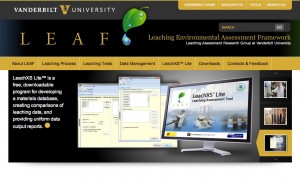LEAF – Leaching Environmental Assessment Framework
A collection of leaching tests, data management tools, and assessment approaches
The Leaching Environmental Assessment Framework (LEAF) is a collection of leaching tests, data management tools, and leaching assessment approaches developed to identify detailed characteristic leaching behaviors of a wide range of solid materials (e.g., wastes, soils, construction products, etc). Cohesive integration of these components provides materials-specific “source term” release information for support of decisions involving materials management.
Collaboration
LEAF is a collaborative research effort between:
- Vanderbilt University School of Engineering, Nashville, TN
- The Energy Research Centre of the Netherlands, Petten, the Netherlands
- DHI, Horsholm, Denmark
- U.S. Environmental Protection Agency (Office of Research & Development and Office of Solid Waste)
Leaching Tests
Leaching tests are used to characterize fundamental leaching behavior of a subject material through interpretation of test results. In addition, testing under specific release conditions provides a basis for comparison both between materials and between model predictions and testing data. Each of the four leaching tests recommended udner LEAF is designed to vary a critical release-controlling parameter (e.g., pH, liquid-to-solid ratio, leaching time) to provide leaching data over a broad range of test conditions.
Data Management
Integration of multi-point leaching tests and support of geochemical speciation modeling requires that a large number of data be maintained, displayed and output for reporting support. The LeachXS Lite™ program facilitates data management and test result visualization by providing tools for importing laboratory data from a provided set of Microsoft Excel®-based spreadsheets, creating comparisons of leaching data for different tests or materials, and outputing data to for uniform reporting.
Assessment Approaches
Depending upon the level detail and precision required, LEAF provides for the use of a wide range of assessment approaches from simple empirical relationships to complex reactive transport models based on geochemical speciation of the solid material. Many of these approaches are implemented within the LeachXS family of programs.
Completed LEAF Methods included in US EPA SW-846
Garrabrants, A.C., D. Kosson, Stefanski L., R. DeLapp, P.F.A.B. Seignette, H.A. van der Sloot, P. Karither, and M. Baldwin. 2012. Interlaboratory Validation of the Leaching Environmental Assessment Framework (LEAF) Method 1313 and Method 1316. U.S. Environmental Protection Agency, Office of Research and Development, Research Triangle Park, NC.
Method 1313: Liquid-Solid Partitioning as a Function of Extract pH using a Parallel Batch Extraction Procedure
Method 1313 describes a leaching extraction procedure for a granular solid material at nine specified pH values used to assess how constituent leaching varies with leachant pH under equilibrium conditions. For many constituents of potential concern (COPCs), solubility and the extent of constituent partitioning into contacting water varies with pH; the pH of leachant in the field may also vary over the range of plausible management (disposal or reuse) options. This test provides information on the intrinsic leaching potential at different pH values, and allows evaluation of leaching potential over the range of plausible field pH values. This method also may be used in conjunction with Method 1314 (Liquid-Solid Partitioning as a Function of Liquid-Solid Ratio) or 1316 (Leaching as a Function of Liquid-to-Solid Ratio) for percolation through granular materials and with Method 1315 (Mass Transfer Rates in Monolithic and Compacted Granular Materials) for mass transfer rate controlled release (i.e., diffusion) from monolithic or compacted granular materials, as needed.
Method 1316: Liquid-Solid Partitioning as a Function of Liquid-Solid Ratio using a Parallel Batch Extraction Procedure.
Method 1316 describes a leaching extraction procedure for a granular solid material at five specified liquid-to-solid ratio (L/S) values used to assess how constituent leaching varies with the relative leachant volume in contact with a solid material under equilibrium conditions, and at the pH generated by the test material. Assessment of leaching over L/S of 0.5 to 10 mL/g-dry provides estimates of initial leachate and pore water composition, as well as cumulative release up to L/S of 10 mL/g-dry for constituents of potential concern (COPCs). The L/S of 10 mL/g-dry parameter is common with the L/S of the Method 1313 (Liquid-Solid Partitioning as a Function of Extract pH) extractions. The method also allows identification of the mode of leaching for constituents (wash out of highly soluble salts or solubility limited leaching) and estimation of constituent depletion by leaching. The results of Method 1314 (Liquid-Solid Partitioning as a Function of Liquid-solid Ratio) provide more reliable initial leaching concentration source term data for groundwater fate and transport modeling. This method also may be used in conjunction with Method 1313 (Leaching as a Function of Eluate pH) and with Method 1315 (Mass Transfer Rates in Monolithic and Compacted Granular Materials) for mass transfer rate controlled release (i.e., diffusion) from monolithic or compacted granular materials, as needed.
Garrabrants, A.C., D.S. Kosson, R. DeLapp, P. Kariher, P.F.A.B Seignette, H.A. van der Sloot, L. Stefanski, and M. Baldwin. 2011. Interlaboratory Validation of the Leaching Environmental Assessment Framework (LEAF) Method 1314 and Method 1315. U.S. Environmental Protection Agency, Office of Research and Development, Research Triangle Park, NC.
(2012) “Interlaboratory Validation of the Leaching Environmental Assessment Framework (LEAF) Method 1314 and Method 1315” (1436 pp, 26.3 MB) Publication No. EPA/600/R-12/624
van der Sloot, H.A. 2012. van der Sloot, H.A., D.S. Kosson, A.C. Garrabrants and J. Arnold. The Impact of Coal Combustion Fly Ash Used as a Supplemental Cementitious material on the Leaching of Constituents from Cements and Concretes. USEPA Office of Research and Development, EPA/600/R‐12/704, October 2012.
(2012) “Impact of Coal Combustion Fly Ash Used as a Supplemental Cementitious Material on the Leaching of Constituents from Cements and Concretes” (95 pp, 2.04 MB) Publication No. EPA/600/R-12/704
SW-846 New Test Methods On-line: EPA Waste’s official compendium of analytical and sampling methods that have been evaluated and approved for use in complying with RCRA regulations.
